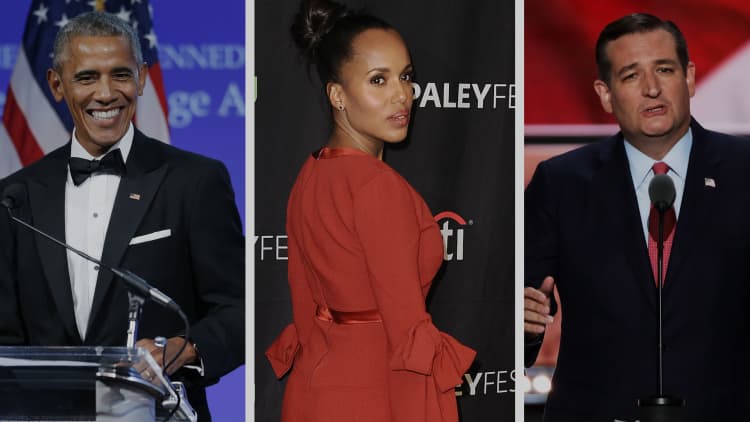Despite the fact that more than 44 million Americans have student loans and their debt now totals $1.4 trillion, many people remain unclear as to how, exactly, those loans work. Financial website Credible created a six question quiz to "gauge public awareness of how rising interest rates might affect the cost of borrowing for college." The quiz surveyed 1,000 students and parents on how interest rates are set, how often those rates are adjusted and whether or not they can change.
A shocking number of them failed.
"More than 9 out of 10 people scored less than 50 percent," Mike Jurs, Credible's director of communications and content, tells CNBC Make It, and 63 percent could answer only one or two questions right. No one was able to answer all seven questions correctly and one in five respondents couldn't guess even a single right answer.
"There's clearly a need for more information about how federal student loans work!" says Jurs.
Below are the questions and the possible answers, including the correct ones, as well as the percentage of respondents who chose each option.
Read on to test your knowledge.
1. Who sets the interest rates on federal student loans?
A. The Department of Education (30.7 percent)
B. The Federal Reserve (18.1 percent)
C. The Consumer Financial Protection Bureau (6.2 percent)
D. Fannie Mae (4.2 percent)
E. Congress and the 10-year Treasury yields (3.7 percent)
F. I don't know (37.1 percent)
The correct answer: E. Congress sets interest rates on federal student loans and mandates rates for new borrowers be adjusted annually based on yields of 10-year Treasury notes.
2. True or false: Once you take out your first federal student loan, you're guaranteed to get the same rate each year you're enrolled in college or grad school.
A. True (23.3 percent)
B. False (48.8 percent)
C. I don't know (27.9 percent)
The correct answer: B. If you take out a federal student loan as a freshman in college, you can expect to pay different rates on loans you take out each academic year ensuing. Rates for new borrowers are adjusted each year based on the 10-year Treasury yields.
3. The interest rates on federal student loans issued today are ...
A. Fixed for the life of the loan (18.1 percent)
B. Variable (24.6 percent)
C. A hybrid of both (8.5 percent)
D. All of the above (18.9 percent)
E. I don't know (29.9 percent)
The correct answer: A. Once a federal student loan is issued, interest rates are fixed for the life of the loan.
4. Which federal student loans carry the highest interest rates?
A. Federal direct loans for undergraduates (15.5 percent)
B. Federal direct loans for graduate students (18.4 percent)
C. Federal PLUS loans for parents and grads (14.4 percent)
D. All federal student loans carry the same rate (9.6 percent)
E. I don't know (42.1 percent)
The correct answer: C. Federal PLUS loans for parents and grad students have the highest interest rates of all federal student loans. "Once students move on to graduate school, they pay higher rates when they take out federal student loans," the survey states.
"The government charges the highest rates of all on federal PLUS loans for graduate students and parents of undergraduates who have hit their limits on more affordable loans."
5. Variable-rate student loans are indexed to which of the following benchmarks?
A. 10-year Treasury notes (15.2 percent)
B. The federal funds rate (28.6 percent)
C. Prime rate or London Interbank Offered Rate (6.4 percent)
D. 30-year mortgage rates (5.8 percent)
E. I don't know (44 percent)
The correct answer: C. Private lenders, in most cases, offer fixed- and variable-rate loans. Variable-rate private loans are indexed to the prime rate or the London Interbank Offered Rate.
6. True or false: Once you have student loans, you can't refinance a better rate.
A. True (21.1 percent)
B. False (47.2 percent)
C. I don't know (31.7 percent)
The correct answer: B. Borrowers who meet certain qualifications can refinance private or federal student loans with private lenders who offer varying rates and repayment options.
Student loan expert Mark Kantrowitz estimates that the annual interest rate on federal loans for undergraduates could hit more than 5 percent by the 2018-2019 academic year. For grad students, interest could reach 6 percent in the same time frame.
And, "for students who borrow for college, rising interest rates may translate into higher monthly student loan payments and thousands of dollars in additional total repayment costs after graduation," Credible chief executive officer Stephen Dash said in the survey.
Here are some tips on how you can recoup the costs of college.
Like this story? Like CNBC Make It on Facebook!
Don't miss: Less than 3 percent of Americans can pass this 6-question money quiz
Video by Andrea Kramar and Zack Guzman




